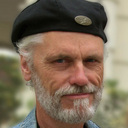0 Likes
Film and TV School (FAMU) is an integral part of The Academy of Performing Arts, which has been found after the World War 2 in 1946. It is one of the oldest film schools in Europe, which kept its tradition even during the difficult time of communist regime. There are many influential filmmakers and scriptwriters among graduates from the school, many of them are known also within international context, e.g.: Stanislav Barabas, Oscar winner Milos Forman, Oscar winner Agnieszka Holland, Věra Chytilova, Juraj Jakubisko, Vojtech Jasny, Woody Vasulka, Lordan Zafranovic, Jan Sverak, Ivan Passer, Goran Paskaljevic, Magnum member Josef Koudelka, Jan Nemec, present Prague and National Rabbi Karol Sidon, Stefan Uher and many others. Also, most of people working in the local film and TV industry either in artistic or production positions, as well as still-photographers in various media are graduates from our school.
The star-studded period form FAMU were the 1960s, but the school managed to retain a comparatively free atmosphere through also the politically repressive 1970s and 1980s. Many professors and graduates emigrated on the other hand, and while abroad, contributed significantly to the education of American cinema school students (especially Frank Daniel and Vojtech Jasny). Foreign contacts were maintained in those days through the International Centre of Cinema and Television Schools CILECT (Centre Interrnational de Liaison des Ecoles de Cinema et de Television) and through international graduate-film reviews at Karlovy Vary - as part of the International Karlovy Vary Film Festival. In November and December 1989 the students and some of the professors of FAMU made a significant contribution to the overthrow of the repressive Communist regime.
The faculty is a founding member of CILECT, of the European League of Institutes of Arts (ELIA) , and of the European Association of Cinema and Television Schools GEECT (Groupement Européen des Ecoles de Cinéma et de Television). Works of its graduates have reaped many awards at international festival and have often been coproduced with and breadcast over domestic television networks.
Structure of FAMU
FAMU (Film and TV school) is one of three parts of the Academy of Performing Arts in Prague. The other schools are the Theater School and the Music School. The Academy is led by the rector (president) and his vice-rectors. There is also the Academic assembly as the top collective institution of the Academy and the Board of Advisors, both on the whole Academy level. This structure is analogically implemented also within each faculty, which is led by the dean. The school is devided into 10 departments: still photography, directing, documentary, scriptwriting, cinematography, sound design, animation, producing, and a recent interdisciplinary department - the Center of Audiovisual Studies. Integral part of the school is the FAMU Studio, providing complete professional facilities from digital Betacam and HDV to 16 and 35mm film for students´ work.
There are 112 professors and instructors, 16 persons administration staff. The Academic assembly has 9 members. The Board of Advisors has 14 members, mostly academics from other universities. There is altogether 350 students in Bc, Mg and PhD study programs plus there is app. 80 international students, taking special study stays or a practical cours, every year.
...





Prague, the capital of the Czech Republic, has long attracted artists and wandering spirits, although it was originally inhabited by prehistoric fish. Their inland sea filled the basin contained by the Tatras and Carpathian mountains, but when it eventually dried up they were forced to yield the terrain to dinosaurs, wooly mammoths and Neanderthals. In human times the Celtic tribes came to reside here, leaving remains dating back to the 4th Century B.C. Their tribal name, Boii, gives the root of the word "Bohemia". The three separate territories of Bohemia, Silesia and Moravia now make up the modern Czech Republic, which split from Slovakia in the 1993 "Velvet Divorce." Thanks to its enigmatic founder, the city of Prague derives a magnetic appeal for visionaries, scientists and astronomers. The historical figure credited with the launch of Prague is Princess Libuse, a visionary prophet and warrior who once stood atop the hill at Vysehrad and made the prophecy as follows, "I see a vast city, whose glory will touch the stars!" This indeed came to pass after she took Otokar Premysl to be her husband and King, launching the Premyslid dynasty, and leaving it to rule for the first four hundred years of Czech history. When the last Premyslid king, Wenceslas III, died without producing a male heir, the fourteen year-old John of Luxembourg came to take the throne of the Czech lands. Hot-headed John died in battle, but his diplomatic son Charles IV inherited the throne and, through keen multi-lingual savvy, managed to both keep it and earn the title "Father of the Czech Nation." Charles IV was the first of the Holy Roman Emperors here; he ruled during the height of Prague's elegance and splendour. This is the man to know if you want to understand Prague's layout. He sponsored the construction of such landmarks as the Charles Bridge, the Hunger Wall and St. Vitus' Cathedral, as well as personally designing the neighborhood called New Town (Nove Mesto) which has for its center Karlovo Namesti or Charles Square. The city displays every branch of architecture across the last thousand years, including Cubism, a style which you will be hard-pressed to find applied to buildings anywhere else in the world. Beyond the stunning visual makeup of the city, there is a wealth of nightlife and entertainment, beginning with the legendary concert halls including the Rudolfinum, National Theater, Estates Theater and the Municipal House. After investigating the Castle and Bridge, which are the most heavily-trafficked tourist areas, take a look around Zizkov and Letna, two of the cooler neighborhoods for bars and restaurants. However quiet it may seem after ten PM, Prague is alive and throbbing in an endless array of basement bars, pubs, clubs, discos and pool halls waiting to be discovered by the intrepid subterranean adventurer. To get an idea of what lies in store, check out the panoramas for Chateau and Palac Akropolis and when you're out and about, make sure you look for the stairs down to the cellar. Apart from shopping, eating, drinking and wearing out your digital camera, delve into the rich green carpet of Prague's parks, many of which lie only walking-minutes from the city center.Text by Steve Smith.